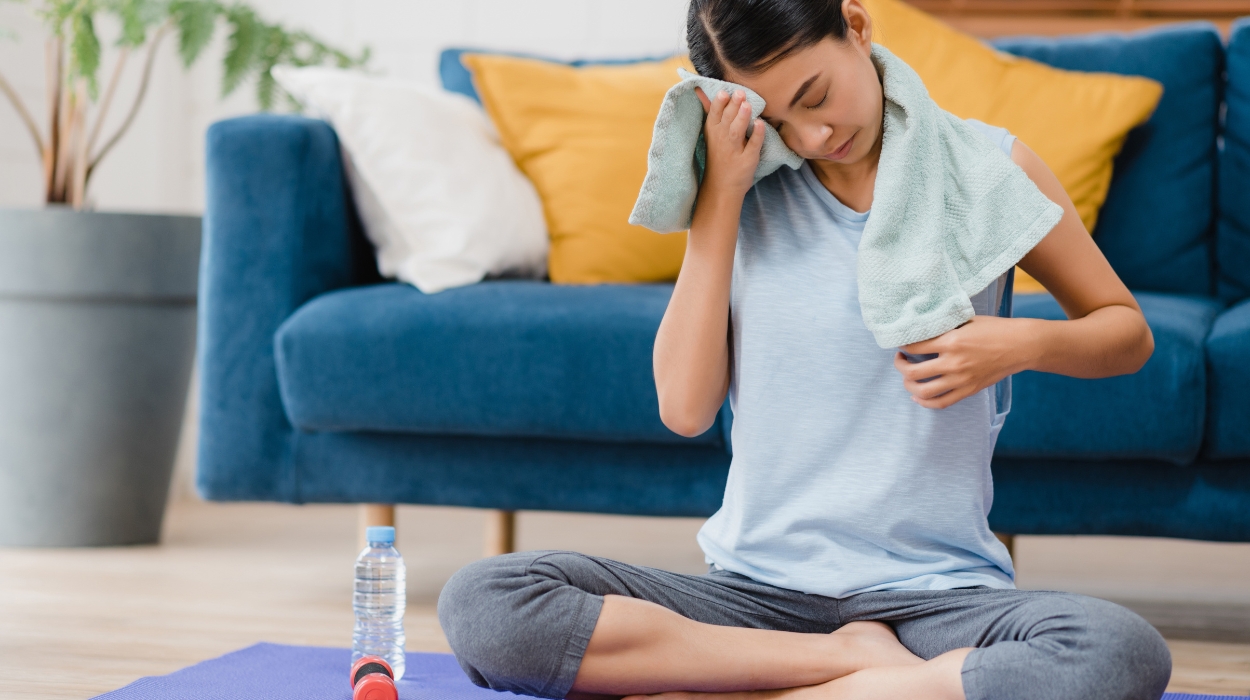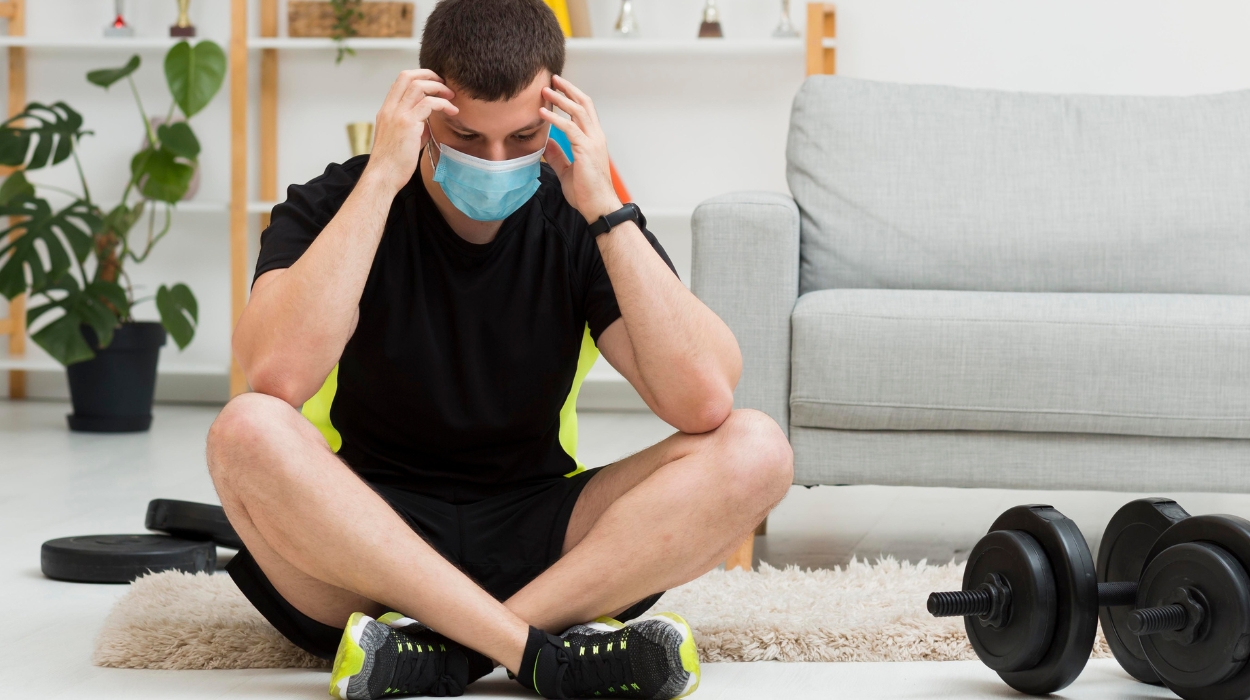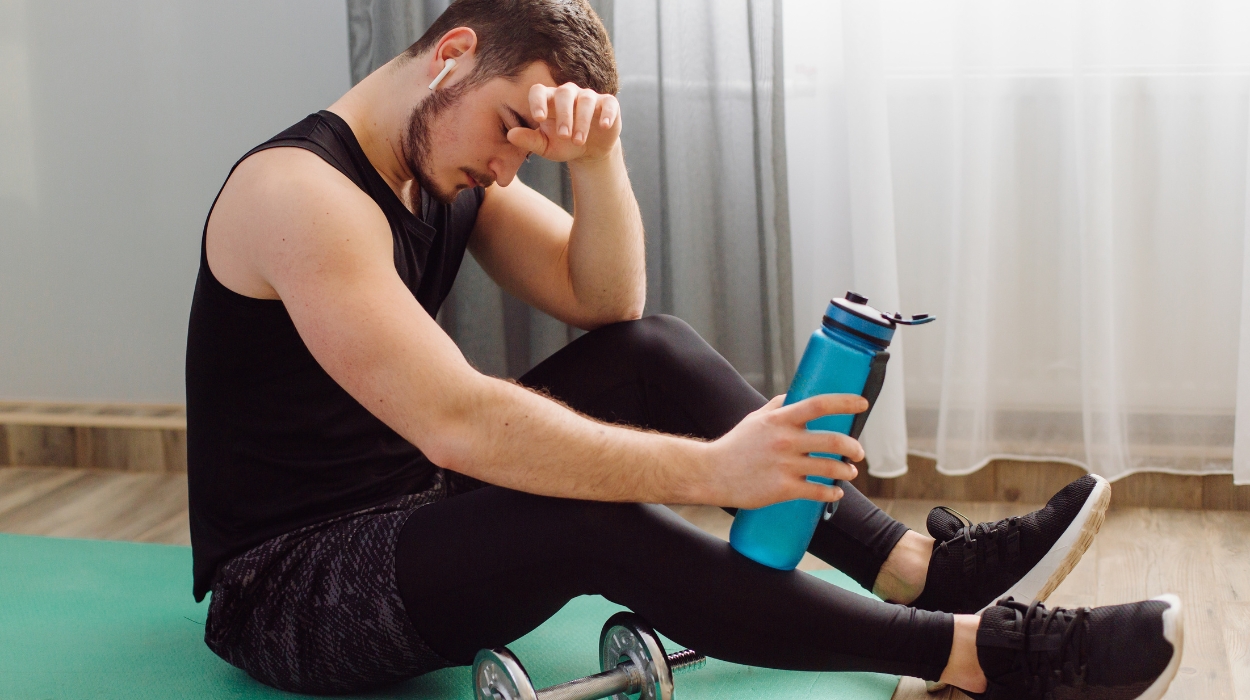 Expert's opinion
Expert's opinion
Expert's opinion
The article is a subjective view on this topic written by writers specializing in medical writing.
It may reflect on a personal journey surrounding struggles with an illness or medical condition, involve product comparisons, diet considerations, or other health-related opinions.
Although the view is entirely that of the writer, it is based on academic experiences and scientific research they have conducted; it is fact-checked by a team of degreed medical experts, and validated by sources attached to the article.
The numbers in parenthesis (1,2,3) will take you to clickable links to related scientific papers.
Working Out When Sick: Good Or Bad & Safety Tips To Follow 2024

When it comes to working out, we’re often told, no pain, no gain, but is that always the case?
If you get home from work late, have a bad sleep, or feel a little sick, the last thing you want to do is work out. With our go-go-go culture, though, resting or taking time off work can be a challenge. Maybe you’re also trying to lose weight, and you’re worried taking a few days off will ruin your streak and set you on the path to weight gain.
But while exercise is great for the immune system,[1] boosting energy levels, and regulating sleep, rest is equally, if not more, important for every area of your health and well-being.
Read on to find out the fine line between taking time off to rest and heal versus pushing yourself and working out while sick.
Should You Workout When Sick?
While exercise is typically touted for its health benefits, listening to your body’s signals and acknowledging the need for rest when feeling unwell is crucial. Depending on individual symptoms, sometimes opting for rest over exercise is the best choice for allowing the body to heal, while in other cases, a gentle workout may be beneficial in alleviating symptoms.
Working Out When Sick: Good Or Bad?

If you’re feeling a little sick and your body is telling you to rest, you might be going through an internal battle in your head, debating whether or not you should push yourself and work out. It’s hard to know when it’s time to rest because we’ve been bombarded with messages always to work hard. The cultural conditioning is to keep going, with workplaces barely offering sick days and the social stigma of being sick as a weakness.
If you decide to take a sick day and pause your workout routine, you might also be ridden with guilt about it. Maybe you’re worried about losing motivation, returning to old unhealthy routines, or gaining weight. Plus, we’re always reminded about how exercise is great for overall physical and mental health.
However, whenever you start feeling under the weather, it’s best to take stock of your symptoms to know what your body needs to heal. With many signs and symptoms of not feeling well, avoiding exercising and lying down to relax is best. With others, a light workout might even help to reduce some symptoms.
The Most Important Thing To Do When Sick
With any illness, prioritizing sleep is one of the best things you can do. Sleep is when your body heals. Cells have time to regenerate, hormone levels can be restored, and your immune system releases cytokines, which help your body fight infection and inflammation.
This is also why it’s a good idea to avoid eating large or hard-to-digest meals before bed. Difficult meals for your stomach include greasy and high-sugar foods, red meat, or alcohol. Digestion takes a lot of energy, and your body will spend time processing food rather than using all its power to focus on healing. Try to eat nutrient-dense and light foods, like fruit, steamed vegetables, and chicken soup.
When Is It Safe To Workout?
The general rule of thumb is to note whether most of your symptoms are above or below the neck. Many doctors say that mild above-the-neck symptoms can be managed with short and light exercise or moderate exercise. Some severe symptoms that would be safe to exercise gently include
- Stuffy or runny nose.
- Nasal congestion
- Mild sore throat.
- Sneezing.
- Light cough.
- Earache.
- Chronic lower back pain.
Types of light exercises safe for mild above-the-neck symptoms are:
- Walking outdoors.
- Light resistance training.
- Gentle yoga or pilates.
Keep in mind that even if you have mild symptoms, it’s best to reduce the intensity of your workout by at least 50%. Your body still needs lots of energy to heal, and working out can stress your body and strain your immune system.
How Exercise Can Help Mild Symptoms
One time when it’s better to work out is for chronic lower back pain.[2] Exercise can reduce pain symptoms and increase strength and flexibility to avoid future issues. Many studies show that pain intensity can be reduced from 10-50% after specific exercise treatment. This exercise treatment also helps to reduce the need for future sick days[3] off from work.
Another example of when exercise might help is with a stuffy nose or the early phase[4] of a flu infection. Working out can help to alleviate some sinus issues by opening the airways. If you’re not noticing an improvement, however, it could be a sign that rest is needed instead.
When Is Exercise Not Recommended?
If most of your symptoms are below the neck, doctors advise bed rest and time off work to allow the body to heal. Some examples of symptoms you shouldn’t work out with are:
- Fever.
- Coughing with phlegm.
- Upset stomach.
- Diarrhea.
- Nausea.
- Severe aches or muscle pain.
If you’re recovering from an injury or surgery, your doctor will let you know when it will be ok to start resuming exercise again. Even if you’re feeling up to it, follow the doctor’s orders to avoid hurting yourself by beginning before your body is truly ready.
Fever
A fever is a sign that your body is fighting off a viral or bacterial infection. In this case, it’s always best to rest. Exercising can increase your heart rate and body temperature, adding even more stress to your body. A fever also leads to dehydration, and working out only increases the risk. On top of that, muscle strength[5] is much weaker, making it more likely that you can injure yourself.
Flu
According to the Centers for Disease Control and Prevention, the flu, or influenza,[6] is a contagious illness with symptoms of body aches, fatigue, coughing, congestion, headaches, and fever or chills. Not everyone who gets the flu has a fever, so you may have this infectious illness without even knowing it. Any of these symptoms combined could be a sign, so avoiding others and getting bed rest is important since it takes a heavy toll on the immune system and takes up to two weeks to recover.
Cold
Working out with a cold depends entirely on the level of symptoms and contact with others. Some people have runny noses and feel fine, while others are stuck in bed, totally depleted of energy. However, if you’ve developed a heavy and persistent cough[7] or phlegm, it’s time to rest.
Also, remember that COVID-19 symptoms can mimic a cold, so avoiding other people is recommended. A light tickle in the throat, on the other hand, isn’t necessarily a reason to avoid a gentle workout.
Digestive Issues
If you’re vomiting, nauseous, or have diarrhea; you may have viral gastroenteritis. It’s an infectious illness, so staying away from others is essential. It’s not recommended to work out or strain yourself in any way. Your body will be infectious and working hard to heal for at least 48 hours.
Lung Or Cardiovascular Symptoms
In general, working out should be avoided when symptoms are related to the heart, lungs, and any large organs in general.
Safety Tips For Exercising While Sick

There are extra precautions you should keep in mind when you exercise. Here are seven tips to remember the next time you decide to work out when feeling exhausted or under the weather:
Listen To Your Body
Even if you technically pass the neck check, it’s still best to only work out if you feel up to it when sick. Exercising takes more energy than most people realize, and you don’t want to finish your workout feeling worse than when you started. Pay attention to how easy or hard it is to move, and if you’re finding it difficult, that’s your body giving you a sign that it doesn’t have the energy to continue.
Hydrate And Eat Well
Doctors always say to drink lots of liquids and rest when you’re feeling sick. It’s especially true to drink more if you’re going to work out. Movement[8] makes your cells move more, use more fluids, and burn glycogen, the sugar stored in muscles. Make the workout as easy on your system as possible by drinking lots of water and eating easy-to-digest nutrient-dense foods. Your body needs all the nutrition it can get to heal itself more quickly.
Take Regular Breaks And Rest
If you have the energy to work out when sick, it’s still important to take lots of breaks during your exercise routine. This way, you can check in with your body and pay attention to any cues that it might be time to rest or end the workout. If you power through and don’t stop until the end, you could feel depleted and have gone too far.
Workout At 50% Of Your Usual Capacity Or Less
Heavy exercise strains the body and adds physiological stress, which can weaken the immune system.[9] Marathon runners, for example, are at increased risk for upper respiratory tract infections for one to two weeks[10] following a race. No matter how much energy you have, plan to go at 50% of your usual capacity or less. Your body needs that extra energy for the internal healing process you don’t see happening.
Prioritize Sleep
Sleep is a priority for both healing and maintaining a healthy immune system. If you’re feeling sick and your workout will interfere with getting enough sleep, it’s probably best to choose to sleep instead. Your immune cells[11] are regulated by the amount of sleep you get, meaning they’ll help you fight any illness better when you’re well-rested.
Avoid Working Out Around Other People
It’s always a good idea to skip the gym or any group activities[12] when you’re feeling ill and fighting an infection. Even if the symptoms seem mild to you, you could infect someone who has a weaker immune system and may get much sicker than you. Much like COVID-19, it doesn’t take much for an infection to spread and hurt more people.
Sweat Less
Just as you need to drink more when sick, it’s also important to sweat less to avoid dehydrating yourself or overworking your heart and organs. Choose a physical activity that won’t strain your cardiovascular system, like light yoga or a walk outdoors.
Summary
Regular exercise routine helps to reduce symptoms and viral loads and increase the body’s immune response when sick. However, exercising isn’t always the best option if you’re feeling under the weather. Your body needs the energy to heal; working out can strain the system and delay healing times.
If most of your symptoms are mild and above the neck, it should be fine to do a gentle workout like yoga or a walk in the park. Should you work out when sick, it’s important to take it slow, get proper nutrition, and take regular breaks to listen to your body and rest whenever possible.
If your symptoms involve any major organs and are below the neck, like a heavy cough, chest congestion, digestion issues, muscle aches, or a fever, you’ll want to avoid working out. It’s also best to avoid being around other people since you may have an infection.
If you’re in doubt, ask your doctor and lean towards the side of caution by taking a rest and allowing your body the time and energy it needs to recover.
+ 12 sources
Health Canal avoids using tertiary references. We have strict sourcing guidelines and rely on peer-reviewed studies, academic researches from medical associations and institutions. To ensure the accuracy of articles in Health Canal, you can read more about the editorial process here
- Nieman, D.C. and Wentz, L.M. (2019). The compelling link between physical activity and the body’s defense system. Journal of Sport and Health Science, [online] 8(3), pp.201–217. doi:https://doi.org/10.1016/j.jshs.2018.09.009.
- Rainville, J., Hartigan, C., Martinez, E., Limke, J., Jouve, C. and Finno, M. (2004). Exercise as a treatment for chronic low back pain. The Spine Journal, [online] 4(1), pp.106–115. doi:https://doi.org/10.1016/s1529-9430(03)00174-8.
- Kellett, K.M., Kellett, D.A. and Nordholm, L.A. (1991). Effects of an Exercise Program on Sick Leave Due to Back Pain. Physical Therapy, [online] 71(4), pp.283–291. doi:https://doi.org/10.1093/ptj/71.4.283.
- Kohut, M.L., Sim, Y.-J., Yu, S., Yoon, K.J. and Loiacono, C.M. (2009). Chronic Exercise Reduces Illness Severity, Decreases Viral Load, and Results in Greater Anti‐Inflammatory Effects than Acute Exercise during Influenza Infection. The Journal of Infectious Diseases, [online] 200(9), pp.1434–1442. doi:https://doi.org/10.1086/606014.
- Dick, N.A. and Diehl, J.J. (2013). Febrile Illness in the Athlete. Sports Health, [online] 6(3), pp.225–231. doi:https://doi.org/10.1177/1941738113508373.
- CDC (2023). Key Facts About Influenza (Flu). [online] Centers for Disease Control and Prevention. Available at: https://www.cdc.gov/flu/about/keyfacts.htm.
- Martin, M.J. and Harrison, T.W. (2015). Causes of chronic productive cough: An approach to management. Respiratory Medicine, [online] 109(9), pp.1105–1113. doi:https://doi.org/10.1016/j.rmed.2015.05.020.
- Lorenzo, I., Mateu Serra-Prat and Juan Carlos Yébenes (2019). The Role of Water Homeostasis in Muscle Function and Frailty: A Review. Nutrients, [online] 11(8), pp.1857–1857. doi:https://doi.org/10.3390/nu11081857.
- Wolfgang Gunzer, Konrad, M. and Pail, E. (2012). Exercise-Induced Immunodepression in Endurance Athletes and Nutritional Intervention with Carbohydrate, Protein and Fat — What Is Possible, What Is Not? Nutrients, [online] 4(9), pp.1187–1212. doi:https://doi.org/10.3390/nu4091187.
- Nieman, D.C. (1997). Immune response to heavy exertion. Journal of Applied Physiology, [online] 82(5), pp.1385–1394. doi:https://doi.org/10.1152/jappl.1997.82.5.1385.
- Besedovsky, L., Lange, T. and Born, J. (2011). Sleep and immune function. Pflügers Archiv – European Journal of Physiology, [online] 463(1), pp.121–137. doi:https://doi.org/10.1007/s00424-011-1044-0.
- Orchard, J.W. and Puranik, R. (2021). ‘Stay home when sick’ advice: implications for sport and exercise. BMJ Open Sport & Exercise Medicine, [online] 7(4), pp.e001227–e001227. doi:https://doi.org/10.1136/bmjsem-2021-001227.



